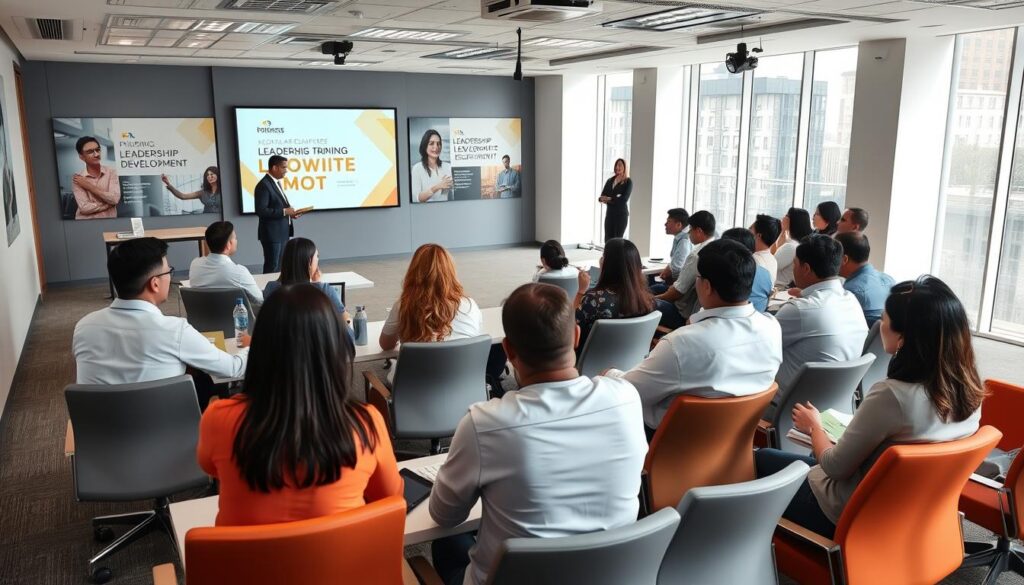In the Philippines, the business world is changing fast. Are companies using effective HR training to stay ahead? This question is key to understanding the importance of training in human resources.
With the economy growing and more jobs needed, training is more important than ever. This article looks at how good HR plans improve skills and help companies win.
Key Takeaways
- HR training programs serve as a cornerstone for employee development.
- Understanding organizational needs is vital for effective training strategies.
- Enhanced employee capabilities lead to improved overall productivity.
- Continual learning fosters a resilient workforce.
- Aligning training with career paths is essential for retention and engagement.
- Investing in leadership development creates future-ready organizations.
The Importance of HR Training and Development in the Philippines
Effective HR training and development are key for business growth in the Philippines. It’s important to know what each organization needs. This helps in creating learning plans that match business goals.
HR managers can spot skill gaps by checking current abilities. They then plan to fill those gaps. This ensures the workforce meets the organization’s needs.
Understanding Organizational Needs
Every company is different, needing unique training. They must do thorough checks to find areas for betterment. This lets HR teams make programs that fit the company’s goals.
These programs help solve immediate skill issues. They also get the team ready for future challenges.
Enhancing Employee Skills and Capabilities
Investing in HR manager training is crucial. It makes the workforce skilled and flexible. Employees get the tools they need to excel.
These efforts boost engagement and productivity. They also create a culture of ongoing learning. As employees grow, so does the company’s success.
Key Benefits of Employee Training Programs
In the Philippines, companies are seeing the value in employee training programs. These efforts bring many benefits, making their workforce more efficient. By focusing on talent development, companies improve productivity and keep their best employees.
Improving Employee Productivity
Training helps employees do their jobs better. They learn the skills they need to work efficiently. This means less mistakes and faster completion of projects.
In a competitive market, training is key to success. It helps companies stand out and achieve their goals.
Boosting Employee Engagement and Retention
Training makes employees feel valued and motivated. This leads to lower turnover rates. It saves companies money on hiring and training new staff.
Happy employees also contribute to a strong team culture. They work better together, making the workplace more positive.

| Benefit | Description | Impact |
|---|---|---|
| Productivity | Improved skills leading to better performance. | Higher operational efficiency and reduced errors. |
| Engagement | Increased employee motivation and commitment. | Strengthened organizational culture and teamwork. |
| Retention | Greater job satisfaction and loyalty. | Lower turnover rates and reduced recruitment costs. |
Strategies for Effective HR Training
Effective HR training starts with knowing what employees need. Companies must tailor their strategies to fit their unique challenges and goals.
Conducting Training Needs Analysis
A detailed Training Needs Analysis (TNA) is key to figuring out the skills needed for each role. This lets companies create specific training plans to fill skill gaps and improve performance. By looking at employee reviews and feedback, companies can make smart choices about their training.
Embracing a Blended Learning Approach
Using different learning methods makes training more engaging. A blended learning approach mixes online and in-person training to meet everyone’s needs. This approach boosts employee engagement and helps companies keep their training effective.
Creating a Culture of Continuous Learning
Building a culture of ongoing learning helps employees grow professionally. Providing ongoing training and resources lets staff improve their skills. This boosts creativity and innovation in the workplace. In today’s competitive job market, companies that focus on continuous learning are more likely to keep their best employees.
Training and Development in Human Resource Management
Good training and development are key for managing human resources well. Training that matches with employees’ career goals boosts motivation and engagement. A clear development path helps keep talent and shows employees their growth in the company.
Aligning Training with Career Paths
Linking HR training with career dreams can greatly improve job satisfaction. When employees see a clear path ahead, they’re more into training. This teamwork between the company and the employee keeps staff happy and productive.
Measuring Training Effectiveness
It’s important to check how well training works. Using tests before and after training shows its real impact. These checks help spot where more help is needed, making training better over time.
With data, companies can make their training programs better. This leads to happier and more skilled employees.

Soft Skills Development in Training Programs
In today’s workplace, soft skills are key. They boost individual performance and team harmony. HR focuses on skills like communication, problem-solving, and teamwork to improve the whole organization.
Importance of Effective Communication
Good communication is vital for a team’s success. It helps everyone understand each other and share ideas easily. Training in communication skills is crucial for clear expression and active listening.
This skill is key for strong relationships with clients and colleagues. It leads to better customer satisfaction and productivity.
Fostering Problem-Solving and Teamwork
Training in problem-solving and teamwork boosts collaboration and performance. Employees learn to solve problems creatively and work together. This builds trust and cooperation in the workplace.
| Soft Skill | Benefits | Training Methods |
|---|---|---|
| Effective Communication | Improved relationship dynamics, reduced misunderstandings | Workshops, role-playing exercises, feedback sessions |
| Problem-Solving | Enhanced creativity in tackling challenges, increased innovation | Case studies, group discussions, simulation activities |
| Teamwork | Strengthened collaboration, increased morale | Team-building exercises, project-based learning, peer collaboration |
Investing in Leadership Development
Effective leadership is key to a successful organization. Investing in HR managers’ professional development, especially in leadership, is crucial. It lays the groundwork for future growth. Structured training for leaders is vital to improve their skills and create a better work environment.
Training for Current and Aspiring Leaders
Learning and development programs for leaders are essential. They help build important skills. These include:
- Strategic thinking
- Effective decision-making
- Team management
- Crisis management
Empowering leaders with these skills motivates teams. It drives success in the organization.
Building a Leadership Pipeline
A strong leadership pipeline is crucial for any organization’s future. It ensures a steady supply of skilled leaders. To achieve this, organizations should:
- Start mentorship programs to guide new leaders.
- Create personalized development plans for each leader.
- Regularly check progress and adjust training as needed.
This approach boosts HR managers’ skills. It also aligns the business’s direction with its leadership goals.

Utilizing Technology in HR Training
Technology is key in making HR training better. Online learning platforms help businesses offer courses that fit everyone’s schedule. This tech-based approach makes learning fun and effective.
Online Learning Platforms
Online learning platforms change how we get HR training. They let employees learn whenever they want. The benefits are clear:
- Learn from anywhere
- Go at your own pace
- Use cool multimedia to keep you interested
Virtual Reality Simulations
Virtual reality simulations add a new level to training. They make learning feel real. It’s great for:
- Understanding complex situations better
- Getting practice in a safe space
- Training everyone the same, no matter where they are
Using these new methods helps companies stay ahead. As tech in HR training gets better, companies will find new ways to build a strong team.
| Technology Type | Benefits | Ideal for |
|---|---|---|
| Online Learning Platforms | Flexible, accessible, and engaging learning | Employees with varying schedules |
| Virtual Reality Simulations | Immersive training for real-world challenges | High-stakes scenarios and remote teams |
Promoting Knowledge Sharing and Mentorship
Creating a culture of knowledge sharing is key to personal and professional growth. Mentorship programs help experienced professionals share their wisdom. This guides less experienced employees, nurturing talent and teamwork.
Establishing Mentorship Programs
Mentorship programs boost individual growth and team unity. They pair seasoned mentors with mentees, using their experience and wisdom. These programs can include:
- Regular meetings to discuss progress and challenges.
- Goal-setting sessions to align expectations and objectives.
- Feedback loops for ongoing communication.
Encouraging Peer-to-Peer Learning Initiatives
Peer-to-peer learning adds to the company’s learning environment. Formats like ‘lunch and learn’ sessions let employees share skills informally. These efforts:
- Encourage a transparent learning environment.
- Spread diverse skills across departments.
- Build a strong, unified corporate culture.

Adapting to Changing Business Environments
Today, businesses face quick changes in markets and landscapes. Updating training helps companies stay ahead. Regular updates to training curricula make sure employees can handle new roles.
Regularly Updating Training Initiatives
It’s key to keep checking HR training programs. Companies should add new trends and listen to employees. This helps employees grow and meet business goals.
Staying Competitive in Talent Acquisition
In today’s job market, companies with modern training attract the best talent. Job seekers want places that offer growth and learning. This makes companies leaders in their fields.
| Aspect | Benefits of Regular Updates | Impact on Talent Acquisition |
|---|---|---|
| Relevance of Content | Ensures training is aligned with current industry standards | Attracts applicants who prioritize modern skills and knowledge |
| Employee Engagement | Boosts morale with fresh training approaches | Increases retention as employees feel valued and invested in |
| Market Adaptability | Equips workforce to tackle emerging challenges | Strengthens company reputation as a forward-thinking employer |
Updating HR training programs regularly is crucial for staying competitive. Companies that focus on learning and development initiatives attract and keep skilled workers.
Conclusion
Training and development are key in human resource management, especially in the Philippines. Companies that focus on good HR training are growing their teams. They also create a culture of growth and innovation.
This effort boosts productivity, makes employees happier, and keeps them loyal. These are important in today’s fast-paced world.
As businesses change, it’s important to update training to meet new needs. Staying committed to improving through training helps companies succeed. By focusing on HR training, companies set themselves up for long-term success.
Embracing training and development helps both employees and companies deal with today’s business challenges. A well-trained team leads to better results for everyone. This makes training a vital part of success.
